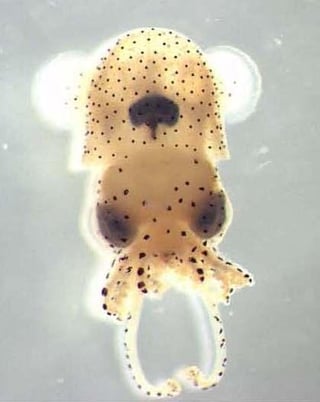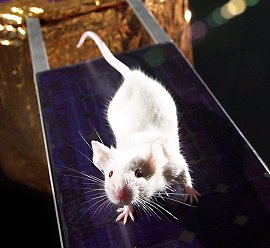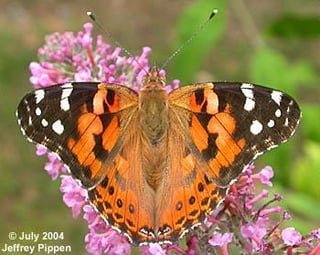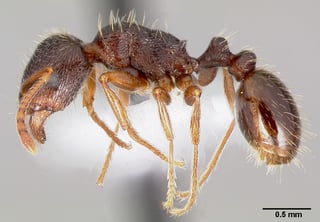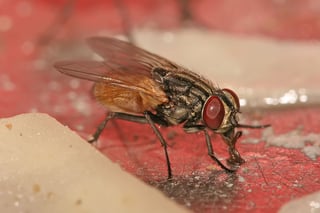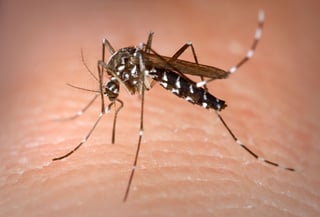I am doing a science project for school and i was wondering if anybody could help me out. I need to know how many and what kinds of animals have been on the iss.
-
$\begingroup$ en.wikipedia.org/wiki/… has a list of experiments that could serve as a starting point, though it appears to be a few years out of date. $\endgroup$– MarkCommented May 11, 2014 at 1:25
-
1$\begingroup$ en.wikipedia.org/wiki/Animals_in_space#2000s $\endgroup$– PearsonArtPhoto ♦Commented May 12, 2014 at 1:00
1 Answer
No answer to this question is likely to be complete, but I have tried to gather what sources are available to give a good representation of the animal research on the International Space Station (ISS).
Here is a list of the types of animals that have been on the ISS with as much detail as I could find about them. The final portion is an attempt at getting a lower limit on their numbers:
- Drosophila melanogaster, a species of fruit fly, more than 450
Credits: NASA
- Caenorhabditis elegans, a species of nematode or roundworm, more than 8 culture bags containing an unspecified amount of nematodes
Credits: Cell Image Library, Bob Goldstein
- Oryzias latipes, a species of rice fish, known as the medaka, the Japanese rice fish, or the Japanese killifish, more than 5
Credits: NASA
- Euprymna scolopes, a species of squid, known as the Hawaiian Bobtail squid, at least 1
Credits: University of Florida, Jamie Foster (used with permission)
- Bombyx mori, a species of silkworm, unspecified amount greater than 1
Larvae pictured. Credits: Wikipedia user Fastily under the Creative Commons Attribution-Share Alike 3.0 Unported license
- Girardia tigrina, a species of planarian or flatworm, unspecified amount greater than 1
Credits: Continenticola under the Creative Commons Attribution CC BY Licence
- Helix lucorum, a species of snail, unspecified amount greater than 7
Credits: "Helix lucorum 2" by Petar Iankov, http://www.ImagesFromBulgaria.com - by Petar Iankov, (caption cropped from original source image by User:Snek01). Licensed under CC BY 2.5 via Wikimedia Commons
- Coturnix japonica, a species of quail, about 36 or more
Credits: "Japanese Quail" by Ingrid Taylar - Flickr: Mikiko the Quail. Licensed under CC BY 2.0 via Commons
- Mus musculus, a species of mouse, much more than 40
Credits: NASA
- Danio rerio, a species of danio fish, known as the zebrafish, at least 18
Credits: JAXA
- Nephila clavipes, a species of golden orb spider, at least 2
Credits: Danielle Anthony
- Vanessa cardui, a species of painted lady butterfly, at least 4
Credits: Jeffery Pippen (used with permission)
- Danaus plexippus, a species of milkweed butterfly, known as the monarch butterfly, unspecified amount likely greater than 1
Credits: NASA
- Tetramorium caespitum, a species of ant, known as the pavement ant, about 800
Credits: "Tetramorium caespitum casent0005827 profile 1" by The photographer and www.antweb.org. Licensed under CC BY-SA 3.0 via Commons
- Bees, unspecified taxon, unspecified amount greater than 1
Credits: NASA
- Tardigrada, the phylum of tardigrades or waterbears, unspecified amount greater than 1
Credits: Bob Goldstein and Vicky Madden, UNC Chapel Hill - http://tardigrades.bio.unc.edu/pictures/ Licensed under CC BY-SA 3.0 via Commons
- Daphnia magna, a species of water flea, unspecified amount greater than 1
Credits: "Daphnia magna-female adult" by Hajime Watanabe - PLoS Genetics, March 2011. Licensed under CC BY 2.5 via Commons
- Artemia, a genus of fairy shrimp, known as the brine shrimp, unspecified amount greater than 1
Credits: "Artemia salina 4" by © Hans Hillewaert. Licensed under CC BY-SA 4.0 via Commons
- Tenebrio molitor, a species of darkling beetle, known as the mealworm beetle, at least 6 to 8
Credits: "Tenebrio molitor MHNT" by Didier Descouens - Own work. Licensed under CC BY-SA 4.0 via Commons
- Pogonomyrmex barbatus, a species of ant, known as the red harvester ant, at least 6
Credits: "Pogonomyrmex barbatus casent0006306 profile 1" by The photographer and www.antweb.org. Licensed under CC BY-SA 3.0 via Commons
- Musca domestica, a species of fly, known as the housefly, unspecified amount greater than 1
Credits: "Musca domestica housefly" by Muhammad Mahdi Karim (www.micro2macro.net) - Own work. Licensed under GFDL 1.2 via Commons
- Streptocephalus, a genus of fairy shrimp, variety used is known as the Dry Lake fairy shrimp, unspecified amount greater than 1
Credits: "Streptocephalus woottoni" by USGS. Licensed under Public Domain via Wikimedia Commons
- Aedes albopictus, a species of mosquito, known as the tiger mosquito or the forest mosquito, unspecified amount greater than 1
Credits: "Aedes Albopictus" by James Gathany/CDC - This media comes from the Centers for Disease Control and Prevention's Public Health Image Library (PHIL), with identification number #4487. Note: Not all PHIL images are public domain; be sure to check copyright status and credit authors and content providers. Licensed under Public Domain via Commons
- Eisenia fetida, a species of earthworm, known as the red wiggler worm, at least 20 to 30
Credits: "Redwiggler1" by Mihai Duguleana; - Transferred from en.wikipedia to Commons. Licensed under Public Domain via Commons
The study of animals on the space station has been very popular with the public to the extent that the Onion, the satirical "news" source, saw fit to make up their own animal for the ISS: Mischievous Raccoon Wreaks Havoc On International Space Station.
It is also possible that some animals, such as dust mites, have gotten on board outside of study purposes. Dust mites were known to inhabit the Mir space station and other space missions. Current allergen studies on the ISS have not involved the detection of dust mites.
Credits: "CSIRO ScienceImage 11085 A scanning electron micrograph of a female dust mite" by CSIRO. Licensed under CC BY 3.0 via Commons
And, of course, there is one I have left off:
- Homo sapiens, a species of hominin, known as the human, 220 and counting
Credits: NASA
Sources:
- International Space Station Experiments by Hardware - 05.06.14 - Biology and Biotechnology - NASA
- Spiders in Space -- Live! - NASA
- Commercial Generic Bioprocessing Apparatus Science Insert - 03: Spiders and Butterflies (CSI-03) - 01.15.14 - NASA
- Space bees - Delft University of Technology
- Ants invade International Space Station...and they're on a mission - Tech Times
- BIOKon In Space (BIOKIS) - 02.12.14 - NASA
- Surface, Water and Air Biocharacterization - A Comprehensive Characterization of Microorganisms and Allergens in Spacecraft Environment (SWAB) - 04.30.14 - NASA
- Survival of dormant organisms after long-term exposure to the space environment - Novikova, et al.
- NanoRacks-Darca Bat Yam High School-Emergence of Artemia Eggs (NanoRacks-DBYHS-Artemia) - 08.27.15 - NASA
- NanoRacks-McMinnville High School-Exoskeleton Density Analysis of Mealworms in a Microgravity Environment (NanoRacks-MHS-Exoskeleton Density ) - 08.27.15 - NASA
- NanoRacks-Valley Christian High School-Ant Colony Behavior in a Microgravity Environment (NanoRacks-VCHS-Ant Colony Behavior) - 08.27.15 - NASA
- NanoRacks-National Center for Earth and Space Science-Yankee Clipper (SSEP Mission 6) (NanoRacks-NCESSE-Yankee Clipper) - 08.27.15
- NanoRacks-NDC-Bell Middle School-Efficiency of Vermicomposting in a Closed System (NanoRacks-NDC-BMS-Vermicomposting) - 08.27.15 - NASA
-
1$\begingroup$ Wonder what happens to all the mites on the body of an astronaut during the course of the stay on the ISS? Does an astronaut have to acclimatize afresh once back? $\endgroup$– EveryoneCommented May 13, 2014 at 18:10
-
1$\begingroup$ Amazing answer and wonderful read. This deserves more up votes. $\endgroup$– ScottCommented May 15, 2014 at 13:23
-
1$\begingroup$ Note to new readers: I just edited this answer to add one I missed, Daphnia magna which was on the ISS in 2011. I have also updated to add the animals from the experiments that have taken place since May 2014 when I last updated this post. $\endgroup$– called2voyage ♦Commented Oct 27, 2015 at 21:39
-
1$\begingroup$ I just joined this community to post this. Mosquito!!!?? Do we really need them in space too!? $\endgroup$– mj_Commented Sep 26, 2019 at 16:36
-
1$\begingroup$ @mj_ You can see in the comments of this answer that the mosquitos were all larvae and were not allowed to develop past that stage. $\endgroup$– called2voyage ♦Commented Sep 26, 2019 at 17:16



